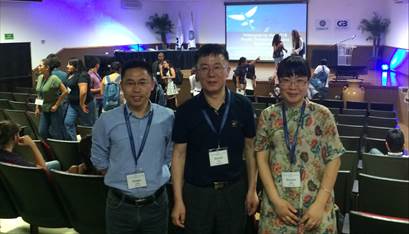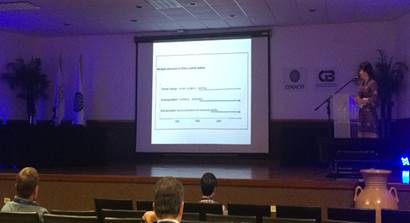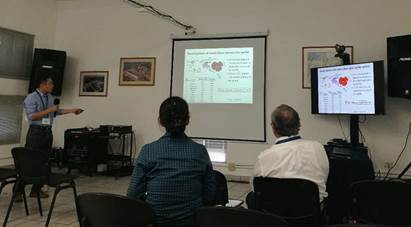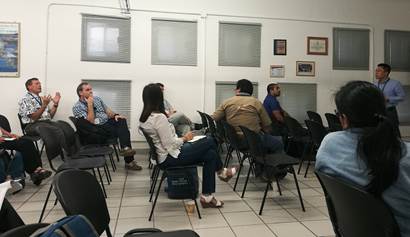During April 23 to April 26, 2018, the International Symposium on "Understanding Changes in Transitional Areas of the Pacific" initiated by the North Pacific Ocean Scientific Organization (PICES) was held in La Paz, Mexico. Dr. Xianshi Jin, Dr. Zengjie Jiang, and Dr. Xiujuan Shan from the Yellow Sea Fisheries Research Institute, Chinese Academy of Fishery Sciences had been invited by Dr. Robin Brown, executive secretary of PICES, to attend the conference.
PICES, an intergovernmental scientific organization established in 1992, is one of the most important international organizations and exchange platforms for marine and fishery science research in the world, which is established by 6 members of Canada, China, Japan, Korea, the United States and Russia. In April 2002, the international PICES symposium on “North Pacific Transitional Areas” was held in La Paz, Mexico. After that meeting, the study of these systems became part of the scientific agenda of many research groups. However, there has been no integrative symposium for the last 15 years. Therefore, the International Symposium "Understanding Changes in Transitional Areas of the Pacific", launched by PICES in 2018, is aimed at exchanging the changes in the structure and function of the ecosystem in the Pacific transitional waters, assessing the impact of such changes on fisheries, and discussing the socio-economic problems in the management of highly migratory resources involved in transitional waters, etc.
The conference was hosted by CIBNOR and CICIMAR in Mexico, and the seminar was assisted by the Tokyo Institute of Atmospheric and Oceanographic Research (AORI), Inter-American Tropical Tuna Commission (IATTC), the United States NOAA, the North Pacific Fisheries Commission (NPFC), and so on. The symposium included 12 plenary presentations, 6 topic sessions and 28 posters, a total of 144 representatives from 12 countries and 6 international or regional organizations attended the conference, including 5 representatives from China. Dr. Jin and Dr. Shan attended the S1; Dr. Jiang attended the S6. Dr. Jin hosted the S5 as the co-chair, and selected the best oral presentation of young scientists.

Team members of the YSFRI delegation
Dr. Jin delivered a presentation entitled "Effects of environmental changes in inshore waters on community structure and population dynamics of exploited marine species". In the presentation, he described the current status of China's fishery resources and related research, and the connection with the CCCC-GLOBEC and PICES-FUTURE projects; introduced the dynamics of China's major fishery populations, and the community structure of fishery species in the Bohai Sea. Taking China's shrimp as an example, he addressed the multi-stressors in China's offshore waters, and the conservation measures of fishery species in China coastal waters, as well as the future marks on the research of fishery resources in China coastal waters.

Dr. Jin delivering a presentation
Dr. Shan delivered a presentation entitled “Biological response of small yellow croaker to multiple stressors: a case study in the Yellow Sea, China”. First of all, the overview of the fishery resources in the Yellow Sea was reviewed, including changes in species composition, CPUE, and nutrition levels. The possible reasons for these changes were further analyzed. Taking small yellow croaker as an example, the changes in body length, body weight, age structure, diet and distribution of small yellow croaker from 1960-2008 years were introduced, and the factors affecting the biological parameters were also analyzed. From 1960 to 2008, The growth rate of the young fish increases, the death rate increases, the body length and weight decrease, what’s more, the age structure is simple, mainly under 3 years of age (mainly in the current year and 1st instar), especially in recent years; the food is mainly from the fish food to the zooplankton feeding, and the feeding is complex. Through analysis, it was found that fishing pressure was an important influence on biological parameters. The biological characteristics of the small yellow croaker have changed significantly. In the management of ecosystem level fisheries, it is suggested that changes in the biological characteristics of the fishery resources be considered as the basic parameters.

Dr. Shan XJ delivering a presentation
Dr. Jiang delivered a presentation entitled “Potential impacts of coastal mariculture on marine ecosystems and sustainable approaches”. He reviewed the development status of mariculture in China and in the world, and analyzed the environmental effects of baiting and non-feeding mariculture types. It emphasized that the importance of mariculture aquaculture assessment in guiding the sustainable development of marine aquaculture. The concept, theoretical basis of multi-nutritional level integrated culture, and the development status of multiple countries under different climate types have also been introduced. Taking Sanggou Bay in Shandong Province as an example to demonstrate the positive effects of various forms of multi-nutritional and hierarchical integrated breeding modes such as fish-shell-algae, shellfish-algae, shellfish-algae-ginseng, etc. implemented in China. The food supply function and ecological service function of this breeding model were analyzed, and the scientific problems and possible solutions in the process of industrialization and popularization of multi nutrient comprehensive aquaculture were prospected.

Dr. Jiang was delivering a presentation as the invited speaker

Discussion on IMTA
Suggestions and future mark:
1. Improve participation in international academic exchanges. The number of Chinese scientists participating in the conference is relatively small, especially young scientists, and it is not possible to display the research progress of our country in this field. It is recommended that all scientific researchers, especially young researchers, be encouraged to actively participate in international academic seminars and promote international studies, in order to promote the integration with the frontiers of international discipline development and the cultivation of young talents.
2. Strengthening the research of large scale and common technical cooperation. The application and influence of regional research are limited to regional scope, which is very restrictive. The research of global large scale and common model and technology will help to improve the research level and international influence in this field.
3. We should strengthen the publicity of the aquaculture mode in China. According to the report of this meeting, China's successful marine ecological aquaculture mode has attracted wide attention from the world's peers, and has aroused active and heated discussions. It is suggested that we should actively participate in relevant international academic exchanges and publicize the successful aquaculture mode in China and enhance our international influence in this field.
